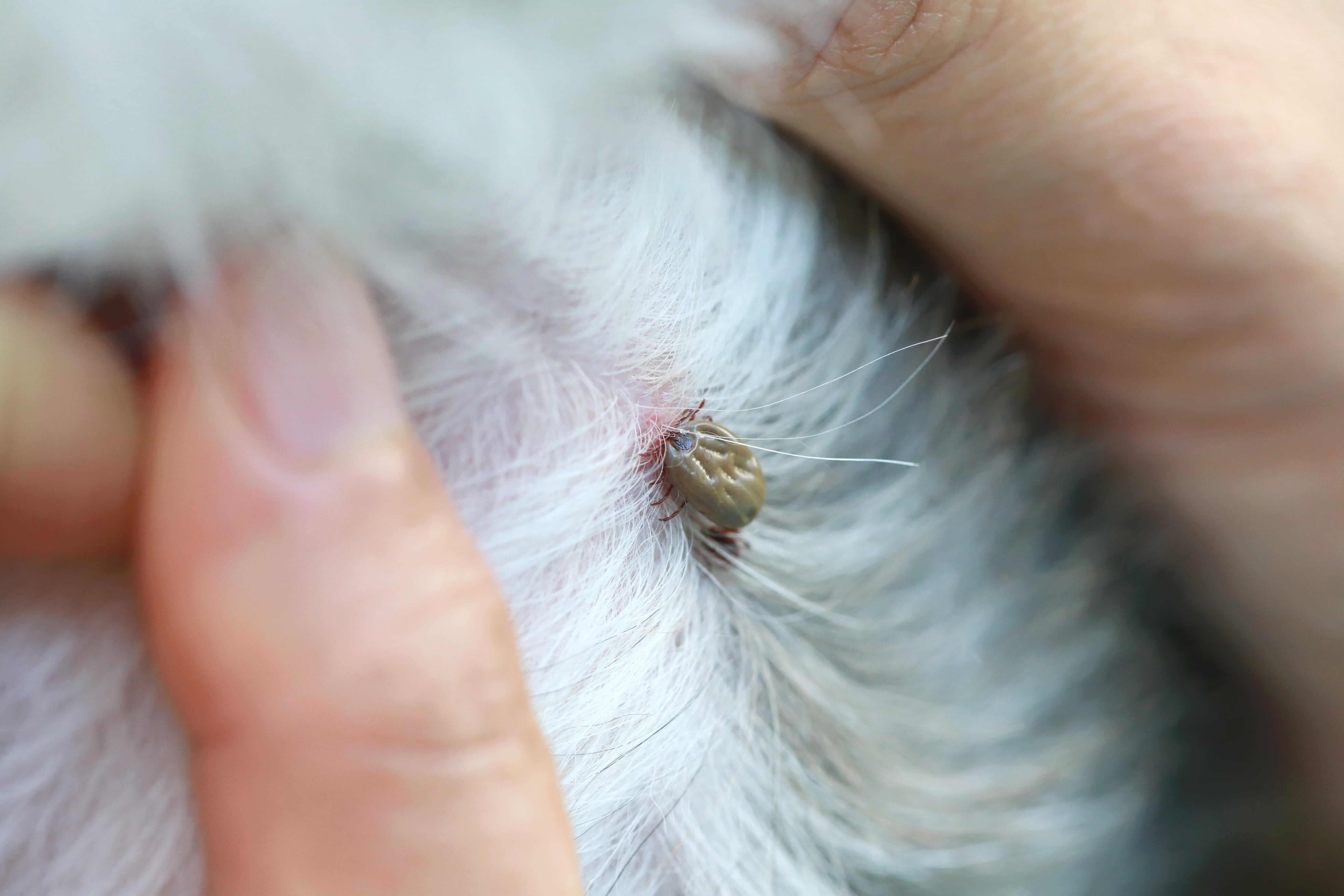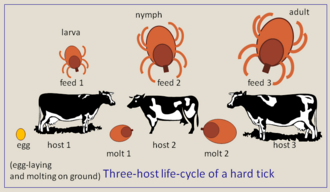To transmit the disease the deer tick must be attached to a dog for 36-48 hours. In this case your dog may have another condition which could require a paralyzed dog wheelchair.
 Tick Control For Dogs Prevention Treatment Tractive Blog
Tick Control For Dogs Prevention Treatment Tractive Blog
Ticks on Dogs Face.

What harm can ticks do to dogs. If the blood-sucking wasnt bad enough these ticks can cause severe life-threatening diseases like the Indian tick typhus or tick fever which can harm dogs. Lyme is transmitted to dogs by the deer tick or black-legged tick Ixodes scapularis. In America the lone star tick is also known to affect dogs however in India there have been very few cases of lone star ticks.
Tick bites have been known to infect dogs with diseases like ehrlichiosis and Lyme disease. Often once a tick is attached dogs dont show any obvious signs they have anything wrong and this is why they can be so dangerous as they may remain hidden from you and potentially put your dog at risk of contracting. If your dog is on tick prevention a tick can still bite your dog but will die before it can cause any negative effects.
Babesia is a protozoan that causes this tick-borne disease in dogs. The longer the tick is attached the higher the chance is that the dog will become infected if the tick is infected. The problem is ticks can transmit infectious diseases such as Lyme disease which can cause serious symptoms in dogs this disease can also affect us if we get bitten by an infected tick.
UK ticks can carry a devastating condition called lyme disease caused by serious bacteria which affects both muscle and nerve cells. The most Common effects of tick bites on dogs that appear 6 to 9 days after the tick has attached to the skin of your dog. Rocky Mountain Spotted Fever.
If youve discovered a tick on your dog it should be removed immediately to avoid a skin reaction and to reduce the likelihood of developing a tick-borne infectious disease. Ehrlichia is caused by a rickettsial organism and is characterized by anemia low platelet counts bleeding fever lethargy neurologic disease and multiple leg arthritis. Hi Bob Ticks can cause Lyme disease in dogs.
This condition occurs when the dog ingests infected ticks affecting the animals digestive system including the liver and lymph. Diseases can be transmitted to your dog in as quickly as a few hours. Deer Ticks on Dogs.
Follow these tips to safely remove a. In case you leave your dogs to run freely they may be infested with deer ticksDeer ticks are also called black-legged ticksIf deer ticks with bite your dog they might infect it with the Lyme diseaseThis disease is caused by borrelia bacteriaIt is transmitted by an infected deer tick. What harm can a tick cause.
Babesiosis in dogs is characterized by the appearance of hemolytic anemia as a result of the destruction to red blood cells. Muscle and joint pain. It does not usually cause symptoms but when there are any they include fever bloody diarrhea vomiting anemia weight loss and paralysis.
Ticks on dogs can cause lyme disease ehrlichiosis and babesiosis. Symptoms of lyme disease include. Can I catch a disease from a tick.
The tick may fall off on its own or you may notice the tick is not alive when you remove it. The good news is that it can be treated with antibiotics. If not treated in time babesiosis in dogs can be fatal.
In fact 75 of dogs living in regions with large numbers of Lyme disease cases are bitten by infected ticks. They can also be carriers of some serious diseases. Ticks can transmit disease in as little as 36 hours so removing them immediately is important.
Read our guide for more information. This is another rickettsial disease transmitted by ticks. Ticks can carry Lyme disease Rocky Mountain spotted fever babesiosis tularemia ehrlichiosis or tick-borne relapsing fever which can all affect animals.
Ticks arent just pests that feast on your dog and cause them to itch. Within two weeks a tick bite on a dog dogs may experience loss of appetite cough pinkeye swelling of the legs and joints seizures skin lesions and renal failure. People can catch lyme disease from ticks just like dogs.
For a disease to transmit ticks typically need to be attached to the host for about 36 to 48 hours thats why early detection and removal is so important. For example your dog may have leg weakness due to another condition which may not be tick related. So if you walk your dog in areas with deer or sheep make sure you take precautions to avoid being bitten.
Ticks on Dogs Belly. Most of the time tick bites do not cause your dog any harm. Lyme disease is seen mostly in the Northeast mid-Atlantic and Midwest.
Studies have shown that once a tick attaches and starts to feed it takes 24 hours to become infected with Lyme disease. This is the most common disease transmitted by ticks in dogs. Lyme disease is serious.
The bad news is that untreated it can be fatal. Symptoms include lameness fever and lethargy. Lyme disease is a tick-borne disease in dogs that is caused by the bacteria Borrelia burgdorferi.
Check behind the ears and. Ticks are the most important external parasites commonly found in cattle and are responsible for severe economic losses both through the direct effects of blood-sucking and indirectly as vectors of pathogens for transmission of the spread of disease.
The Ornate Cow Tick Dermacentor reticulatus.

Do ticks affect cows. Its wounds may attract flies which lay their eggs again the larva may be formed. Cattle become infected when they are bitten by infected ticks and the bacterium passes into the bloodstream. Heavy cattle-tick infestation causes tick-worry and blood loss which leads to loss of condition and sometimes death.
This tick is currently only recorded in W Wales NS Devon and Essex mainly in coastal sand dunes and marsh but recently in Essex grassland 5. The ticks can carry parasites that cause cattle fever a significant and often fatal disease in livestock. There are four stages in the life cycle of ticks.
Cattle ticks are found widely in northern Australia from northern parts of Western Australian and the Northern Territory eastern and northern regions of Queensland and into. Hair loss is common when cows with hair have ticks. Also called a.
They can also carry and transmit tick fever organisms which cause illness and death in cattle. Others however can transmit diseases and cause significant production losses resulting in severe welfare concerns if the infestation is not addressed. Injuries or wounds from its bites may lead to a secondary infection.
Larger ticks cause obstructive and painful damage such as Amblyomma variegatum adults which often feed on udders of cattle and reduce suckling by the calves. Anemia is the. Ticks affect milk production in cattle.
Hyalomma truncatum adults feed on the feet of sheep and goats causing lameness. The disease is usually first reported in cattle in May or June when ticks start to become active. Heavy burdens of paralysis ticks are rare and they are usually present in mixed infestations with bush ticks.
It carries canine babesiosis which is a risk to dogs and it is implicated in transmission of Tick-borne Encephalitis TBE. The cattle tick Rhipicephalus microplus is an important external parasite of cattle although other animals such as horses buffalo sheep and camelids can be affected too. There has never been a confirmed case of Lyme disease originating from a tick.
Life History of Ticks. The disease causes anemia rapid breathing weight loss decreased milk production and death. Ous ticks of all stages 10 and thereby divert subadult vector ticks from feeding on reservoir-competent hosts.
Of the infected cattle that have not been exposed to the disease previously 70 to 90 percent die. A simulation model indicated that the availability of incom-petent hosts for subadult tick stages would reduce preva-lence of infection 24. The egg the six-legged.
Each fattened female tick can be responsible for up to 89 mL of milk reduction. The tick also transmits the protozoan Babesia bigemina which causes Texas Cattle fever a devastating disease of the cattle industry. Cattle in the UK are affected by a wide range of ectoparasites.
3 Common Types of Ticks on Cows American Dog Tick. New cases may then continue to appear through to the autumn. Other estimates indicate that losses in milk production reach 23.
Some symptoms of ticks include. The direct effect of ticks on dairy cattle can reduce total milk production by approximately 90 llactationcow. Spinose ear ticks are found in western North America and frequently infest livestock especially cattle and horses.
Tick paralysis can also affect cattle dogs and some other mammals. For more information click here. Cattle tick infestation is a notifiable disease in NSW.
Fortunately the most important tick-borne disease in North America Lyme disease is not present in wild animal populations in Colorado ie not endemic. These are some of the serious diseases caused by ticks or associated with ticks Diseases Humans or animals affected Tick paralysis Mainly sheep and goats Spring lamb paralysis Lambs and sometimes calves Sweating sickness Cattle especially calves Tick-borne diseases Cattle sheep and goats Tick-bite fever Man Tick paralysis Man. Larva or seed tick the nymph and the.
Our observation that questing nymphal and adult ticks collected on a cattle pasture were. The spinose ear tick enjoys taking up residence in the ears of cattle and other livestock. You should see some red or bumpy patches in the skin of your cows with ticks.
If left unchecked this parasite can significantly reduce cattle live-weight gain and milk production. The three main ticks of concern in NSW are the paralysis tick the bush tick and the cattle tick. Information on identifying ticks can be found.
Red Water Fever is caused by the protozoan parasite Babesia divergens. Tick bites also reduce the quality of hides and skins. Some of these are simply nuisance pests affecting grazing patterns and causing mild irritation.
Seen most often east of the Rocky Mountains the American dog tick is a commonly seen tick that. You will notice some parts of their skin are exposed. Ticks produced on wildlife can reinfest treated cattle and they continually pose a problem for Arkansas cattle producers.
Ticks are also capable of transmitting diseases such as anaplasmosis to cattle.
